Mission type Test flight SATCAT no. 576 Period 1.5 hours Launch date 15 May 1963 | COSPAR ID 1963-015A Orbits completed 22 Apogee 265,000 m Dates 15 May 1963 – 16 May 1963 Landing date 16 May 1963 | |
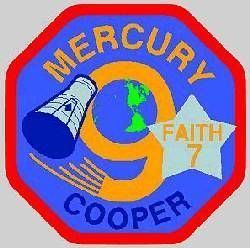 | ||
Mission duration 34 hours, 19 minutes, 49 seconds Distance travelled 878,971 kilometers (474,606 nautical miles) | ||
Mercury-Atlas 9 was the final manned space mission of the U.S. Mercury program, launched on May 15, 1963 from Launch Complex 14 at Cape Canaveral, Florida. The spacecraft, named Faith 7, completed 22 Earth orbits before splashing down in the Pacific Ocean, piloted by astronaut Gordon Cooper, then an Air Force major. The Atlas rocket was No. 130-D, and the Mercury spacecraft was No. 20. This mission marks the last time an American was launched alone to conduct an entirely solo orbital mission.
Contents
- Flight directors
- Mission parameters
- Mission highlights
- Technical problems on the flight
- Spacecraft location
- References

Flight directors
Mission parameters
Mission highlights
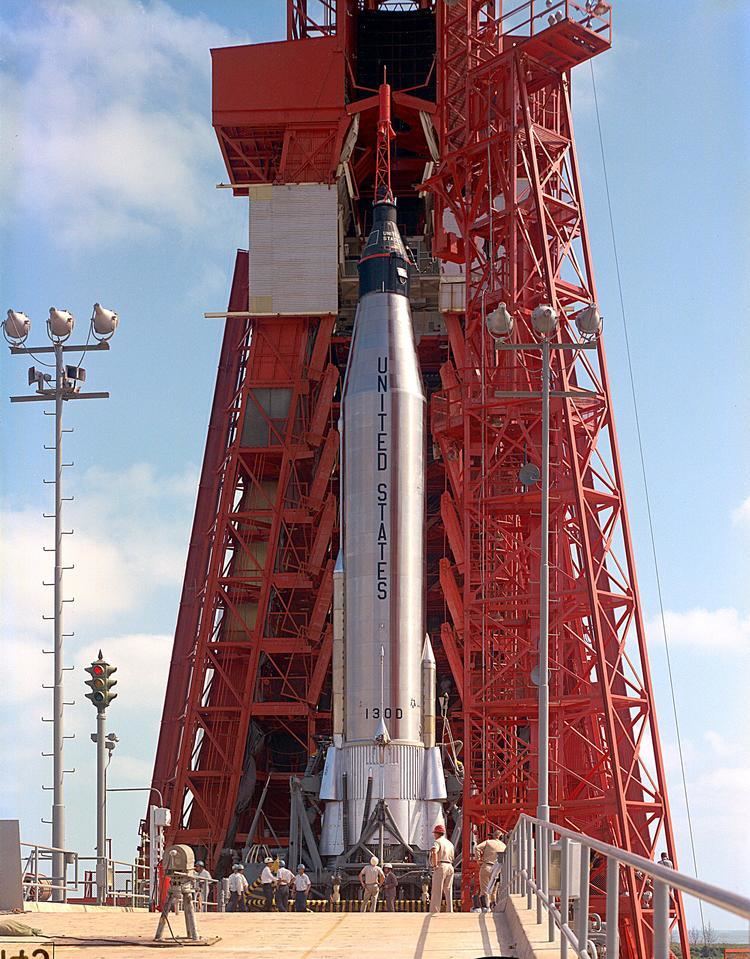
The flight of Sigma 7 had been so nearly perfect that some at NASA thought America should quit while it was ahead and make MA-8 the last Mercury mission, and not risk the chance of future disaster. NASA had pushed the first-generation Mercury hardware far enough, and taking more chances on another longer mission was not warranted; instead, they should move on to the Gemini program.
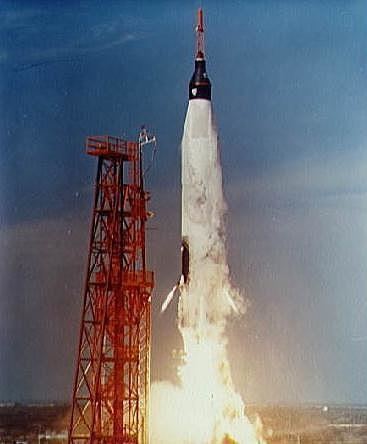
Manned Spacecraft Center officials, however, believed that the Mercury team should be given the chance to test man in space for a full day. In addition, all of the Soviet single-seat Vostok spacecraft launched after Vostok 1 lasted for more than a day, thus the Mercury 9 flight would bring the Mercury spacecraft up to the same level as that of the Soviets.
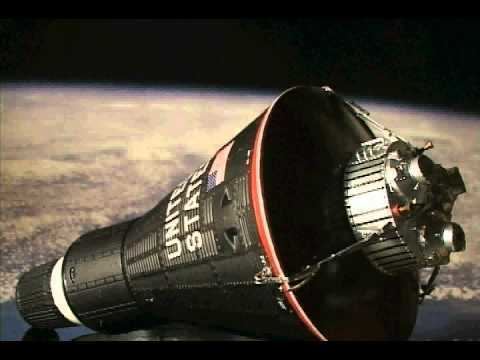
In September 1962, NASA concluded negotiations with McDonnell to modify four Mercury spacecraft (#12, #15, #17 and #20) to a configuration that supported a one-day mission. Such changes to the spacecraft included the removal of the periscope, a redundant set of thrusters, and the addition of extra batteries and oxygen tanks.
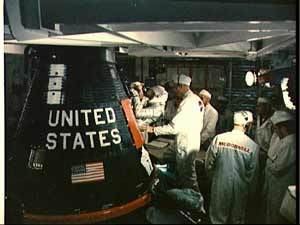
In November 1962, Gordon Cooper was chosen to pilot the MA-9 mission and Alan Shepard was picked as backup.
On April 22, 1963, Atlas booster 130-D and Mercury spacecraft #20 were stacked on the launch pad at Launch Complex 14.
Because MA-9 would orbit over nearly every part of the world from 32.5 degrees north to 32.5 degrees south, a total of 28 ships, 171 aircraft, and 18,000 servicemen were assigned to support the mission.
The Atlas booster used for MA-9 sported several technical improvements, most notably an enhanced propulsion system with a hypergolic igniter that would eliminate the need for hold-down time at launch to prevent rough combustion. With seven successful Mercury launches in a row, the failures of the early days seemed like a distant memory by early 1963 and NASA officials had a high degree of confidence in the Atlas that overshadowed its still spotty launch record. At the first meeting of senior MSFC officials for the year (January 4), Walter Williams noted that the Air Force had yet to provide an explanation for two Atlas F tests in 1962 which ended in explosions shortly after launch. Until the investigating committees released their findings and cleared the Atlas D of guilt by association, MA-9 could be delayed. Five Atlas failures (four of them Atlas Ds) occurred during the first three months of 1963. NASA were therefore wise to not let their guard down even with Mercury's recent success and the strenuous checkout and quality control program implemented on Mercury-Atlas vehicles.
When Atlas 130D received its factory rollout on January 30, it was found to have damaged wiring and had to be sent back for repairs. At his first press conference on February 8, Gordon Cooper admitted to not knowing much about the booster problems and focused instead on the enhancements made to his Mercury capsule. The numerous added equipment and consumables for the day-long mission boosted the weight of Faith 7 considerably; it now weighed over 3000 pounds.
On March 15, the Atlas was rolled out of the factory a second time and passed tests with flying colors; Convair engineers expressed confidence that this "was their best bird yet". Aside from the new propulsion system, the booster received some slight modifications to the engine offsets to counteract the potentially dangerous roll that occurred during Schirra's launch.
Cooper's decision to name his capsule "Faith 7" was based on the faith he had in the Atlas booster and Mercury capsule to carry out the mission successfully, although it was reported in the Washington Post that some NASA officials were skeptical of the idea.
When Cooper boarded Faith 7 at 6:36 am on the morning of May 14, he found a little gift that had been left for him. Alan Shepard, knowing that Cooper would have a new version of the urine containment device that Shepard did not have on his Mercury-Redstone 3 flight (forcing him to relieve himself during a long countdown hold), had left behind a toilet plunger as a joke. Instructions on the handle said, "Remove Before Launch". The gift did not make the trip. Neither did Cooper that day. Various problems with radar in Bermuda and the diesel engine that rolled back the gantry caused the launch to be cancelled until May 15.
At 8:04:13 a.m. EST, May 15, 1963, Faith 7 was launched from Launch Complex 14. At T+60 seconds, the Atlas started its pitch program. Shortly afterward, MA-9 passed through max Q. At T+2 minutes 14 seconds Cooper felt BECO (Booster Engine Cutoff) and staging. The two Atlas booster engines had been left behind. The Launch Escape Tower was then jettisoned. At T+3 minutes the cabin pressure sealed at 5.5 psi (38 kPa). Cooper reported, "Faith 7 is all go."
At about T+5 minutes was SECO (Sustainer Engine Cutoff) and Faith 7 entered orbit at 17,547 mph (7,844 m/s). After the spacecraft separated and turned around to orbit attitude, Cooper watched his Atlas booster lag behind and tumble for about eight minutes. Over Zanzibar on the first orbit, he learned that the orbital parameters were good enough for at least 20 orbits. As the spacecraft passed over Guaymas, Mexico still on the first orbit, capsule communicator Gus Grissom told Cooper the ground computers said he was "go for seven orbits".
At the start of the third orbit, Cooper checked his list of 11 experiments that were on his schedule. His first task was to eject a six-inch (152 mm) diameter sphere, equipped with xenon strobe lights, from the nose of the spacecraft. This experiment was designed to test his ability to spot and track a flashing beacon in orbit. At T+3 hours 25 minutes, Cooper flipped the switch and heard and felt the beacon detach from the spacecraft. He tried to see the flashing light in the approaching dusk and on the nightside pass, but failed to do so. On the fourth orbit, he did spot the beacon and saw it pulsing. Cooper reported to Scott Carpenter on Kauai, Hawaii, "I was with the little rascal all night." He also spotted the beacon on his fifth and sixth orbits.
Also on the sixth orbit, at about T+9 hours, Cooper set up cameras, adjusted the spacecraft attitude and set switches to deploy a tethered balloon from the nose of the spacecraft. It was a 30-inch (762 mm) PET film balloon painted fluorescent orange, inflated with nitrogen and attached to a 100 feet (30 m) nylon line from the antenna canister. A strain gauge in the antenna canister would measure differences in atmospheric drag between the 100 miles (160 km) perigee and the 160 miles (260 km) apogee. Cooper tried several times to eject the balloon, but it failed to eject.
Cooper passed Schirra's orbital record on the seventh orbit while he was engaged in radiation experiments. After 10 hours, the Zanzibar tracking station informed Cooper the flight was a go for 17 orbits. Cooper was orbiting the Earth every 88 minutes 45 seconds at an inclination of 32.55 degrees to the equator.
His scheduled rest period was during orbits 9 through 13. He had a dinner of powdered roast beef mush and some water, took pictures of Asia and reported the spacecraft condition. Cooper was not sleepy and during orbit 9 took some of the best photos made during his flight. He took pictures of the Tibetan highlands and of the Himalayas.
During the flight Cooper reported that he could see roads, rivers, small villages, and even individual houses if the lighting and background conditions were right. This was later confirmed by the two-man Gemini crews that later flew (of which Cooper was included). Cooper slept intermittently the next six hours, during orbits 10 through 13. He woke from time to time and took more pictures, taped status reports, and kept adjusting his spacesuit temperature control which kept getting too hot or too cold.
On his fourteenth orbit, Cooper took an assessment of the spacecraft condition. The oxygen supply was sufficient. The peroxide fuel for attitude control was 69 percent in the automatic tank and 95 percent in the manual one. On the fifteenth orbit, he spent most of the time calibrating equipment and synchronizing clocks.
When he entered night on the sixteenth orbit, Cooper pitched the spacecraft to slowly follow the plane of the ecliptic. Through the spacecraft window he viewed the zodiacal light and night airglow layer. He took pictures of these two "dim light" phenomena from Zanzibar, across the Earth's nightside, to Canton Island. The pictures were later found to have been overexposed, but they still contained valuable data.
At the start of the 17th orbit while crossing Cape Canaveral, Florida, Cooper transmitted slow scan black and white television pictures to Mercury Control. The picture showed a ghostly image of the astronaut. In the murky picture, a helmet and hoses could be seen. It was the first time an American astronaut had sent back television images from space.
On the 17th and 18th orbits, Cooper took infrared weather photos and moonset Earth-limb pictures. He also resumed Geiger counter measurements of radiation. He sang during orbits 18 and 19, and marveled at the greenery of Earth. It was nearing thirty hours since liftoff.
Technical problems on the flight
On the 19th orbit, the first sign of trouble appeared when the spacecraft 0.05 g (0.5 m/s²) light came on. However, this turned out to be a faulty indicator, and the spacecraft was not reentering. On the 20th orbit, Cooper lost all attitude readings. The 21st orbit saw a short-circuit occur in the bus bar serving the 250 volt main inverter. This left the automatic stabilization and control system without electric power.
On the 21st orbit, John Glenn on board the tracking ship Coastal Sentry Quebec near Kyūshū, Japan, helped Cooper prepare a revised checklist for retrofire. Due to the system malfunctions, many of the steps would have to be done manually. Only Hawaii and Zanzibar were in radio range on this last orbit, but communications were good. Cooper noted that the carbon dioxide level was rising in the cabin and in his spacesuit. He told Carpenter as he passed over Zanzibar, "Things are beginning to stack up a little." Throughout the problems, Cooper remained cool, calm and collected.
At the end of the 21st orbit, Cooper again contacted Glenn on the Coastal Sentry Quebec. He reported the spacecraft was in retro attitude and holding manually. The checklist was complete. Glenn gave a ten-second countdown to retrofire. Cooper kept the spacecraft aligned at a 34° pitchdown angle and manually fired the retrorockets on "Mark!".
Cooper had drawn lines on the window to stay aligned with constellations as he flew the craft. He later said he used his wristwatch to time the burn and his eyes to maintain attitude.
Fifteen minutes later Faith 7 landed just four miles (6 km) from the prime recovery ship, the carrier USS Kearsarge. This was the most accurate landing to date, despite the lack of automatic controls. Faith 7 landed 70 nautical miles (130 km) southeast of Midway Island, in the Pacific Ocean. This would be near 27°30′N 176°15′W.
Splashdown was at 34 hours 19 minutes 49 seconds after liftoff. The spacecraft tipped over in the water momentarily, then righted itself. Helicopters dropped rescue swimmers and relayed Cooper's request of an Air Force officer for permission to be hoisted aboard the Navy's carrier. Permission was granted. Forty minutes later the explosive hatch blew open on the deck of the Kearsarge. Cooper stepped out of Faith 7 to a warm greeting.
After the MA-9 mission, there was another debate about whether to fly one more Mercury flight, Mercury-Atlas 10 (MA-10). It was proposed as a three-day, 48-orbit mission to be flown by Alan Shepard in October 1963. In the end, NASA officials decided it was time to move on to Project Gemini and MA-10 never flew.
The Mercury program had fulfilled all of its goals.
Spacecraft location
The Faith 7 spacecraft is currently displayed at Space Center Houston, Houston, Texas.
